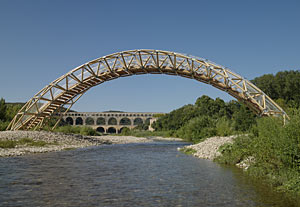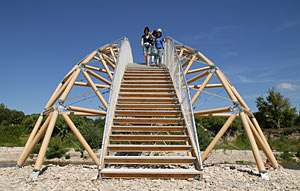Japanese architect Shigeru Ban, known for his cardboard houses, has just installed his latest endeavor in the paper-building world—a temporary bridge over the Gardon River, in the south of France. The 7.5-ton structure is made of 281 of Shigeru’s trademark cardboard tubes, each of which measures 4 inches across and 0.47 inches thick. It provides a visual foil to the nearby Pont du Gard: an ancient Roman bridge now listed as a World Heritage site by the United Nations Educational Scientific and Cultural Organization.


Photos: © Didier Boy de la Tour
“The cardboard is an interesting contrast to the heavy stone structure,” Ban says. “The shape is based on the shape of the Roman arch to give the two bridges some harmony.” The steps of his bridge are made from recycled paper and plastic, while wooden boxes packed with sand comprise the foundations. “I chose the cardboard because it was light weight and it had to be easy to dismantle, and the materials were easy to collect locally.”
Ban adds that he designed the bridge so that it would be simple to build. A team of two-dozen architecture students from France, as well as three Japanese students, erected it during the course of a month. They used balloons filled with 1.5 tons of water to test the bridge’s resistance and to ensure it could support a load of up to 20 people.
The bridge, which opened on July 30, will remain up for a total of six weeks before it is dismantled in time for the start of France’s rainy season. It will be reinstalled next year, most likely in the same location.
Other Ban projects that employ cardboard tubing include the Paper Arch, installed in the Museum of Modern Art in 2000, and the Paper Temporary Studio, erected in Paris in 2004. He is currently applying his philosophy of merging contemporary design with existing historical architecture at the Centre Pompidou Metz, in France’s Lorraine region. Three 285-foot-long and 49-foot-wide cantilevered rectangular volumes containing galleries will be positioned facing the city of Metz’s historic monuments, including a railway station and cathedral.



Post a comment to this article
Report Abusive Comment